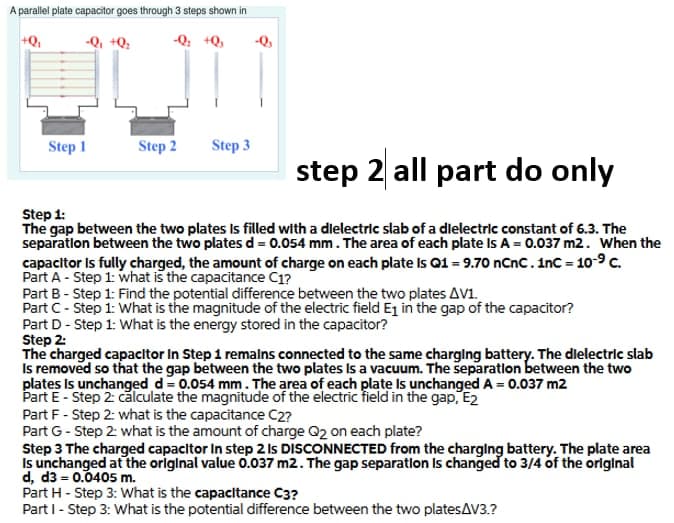Step 2: The charged capacitor In Step 1 remalns connected to the same charglng battery. The dlelectric slab Is removed so that the gap between the two plates Is a vacuum. The separatlon between the two plates Is unchanged d=0.054 mm. The area of each plate Is unchanged A = 0.037 m2 E- Step 2: calculate the magnitude of the electric field in the gap, E2 Part F - Step 2: what is the capacitance C2? Part G- Step 2: what is the amount of charge Q2 on each plate?
Step 2: The charged capacitor In Step 1 remalns connected to the same charglng battery. The dlelectric slab Is removed so that the gap between the two plates Is a vacuum. The separatlon between the two plates Is unchanged d=0.054 mm. The area of each plate Is unchanged A = 0.037 m2 E- Step 2: calculate the magnitude of the electric field in the gap, E2 Part F - Step 2: what is the capacitance C2? Part G- Step 2: what is the amount of charge Q2 on each plate?
College Physics
10th Edition
ISBN:9781285737027
Author:Raymond A. Serway, Chris Vuille
Publisher:Raymond A. Serway, Chris Vuille
Chapter16: Electrical Energy And Capacitance
Section: Chapter Questions
Problem 5CQ: A parallel-plate capacitor with capacitance C0 stores charge of magnitude Q0 on plates of area A0...
Related questions
Question
i need the answer quickly

Transcribed Image Text:A parallel plate capacitor goes through 3 steps shown in
+Q,
-Q, +Q:
-Q: +Q,
-Q,
Step 1
Step 2
Step 3
step 2 all part do only
Step 1:
The gap between the two plates Is illed with a dlelectric slab of a dlelectric constant of 6.3. The
separatlon between the two plates d= 0.054 mm. The area of each plate Is A = 0.037 m2. When the
capacitor Is fully charged, the amount of charge on each plate Is Q1 = 9.70 nCnc.inc = 10-9c.
Part A - Step 1: what is the capacitance C1?
Part B - Step 1: Find the potential difference between the two plates AV1.
Part C- Step 1: What is the magnitude of the electric field Ej in the gap of the capacitor?
Part D- Step 1: What is the energy stored in the capacitor?
Step 2:
The charged capacitor In Step 1 remalns connected to the same charglng battery. The dlelectric slab
Is removed so that the gap between the two plates Is a vacuum. The separatlon between the two
plates Is unchanged d= 0.054 mm. The area of each plate Is unchanged A = 0.037 m2
E- Step 2: călculate the magnitude of the electric field in the gap, E2
Part F - Step 2: what is the capacitance C2?
Part G - Step 2: what is the amount of charge Q2 on each plate?
Step 3 The charged capacitor In step 2 Is DISCONNECTED from the charglng battery. The plate area
Is unchanged at the original value 0.037 m2. The gap separatlon Is changed to 3/4 of the orlginal
d, d3 = 0.0405 m.
Part H - Step 3: What is the capacitance C3?
Part I - Step 3: What is the potential difference between the two platesAV3.?
Expert Solution
This question has been solved!
Explore an expertly crafted, step-by-step solution for a thorough understanding of key concepts.
This is a popular solution!
Trending now
This is a popular solution!
Step by step
Solved in 6 steps with 10 images

Recommended textbooks for you

College Physics
Physics
ISBN:
9781285737027
Author:
Raymond A. Serway, Chris Vuille
Publisher:
Cengage Learning

Principles of Physics: A Calculus-Based Text
Physics
ISBN:
9781133104261
Author:
Raymond A. Serway, John W. Jewett
Publisher:
Cengage Learning

College Physics
Physics
ISBN:
9781305952300
Author:
Raymond A. Serway, Chris Vuille
Publisher:
Cengage Learning

College Physics
Physics
ISBN:
9781285737027
Author:
Raymond A. Serway, Chris Vuille
Publisher:
Cengage Learning

Principles of Physics: A Calculus-Based Text
Physics
ISBN:
9781133104261
Author:
Raymond A. Serway, John W. Jewett
Publisher:
Cengage Learning

College Physics
Physics
ISBN:
9781305952300
Author:
Raymond A. Serway, Chris Vuille
Publisher:
Cengage Learning

Physics for Scientists and Engineers, Technology …
Physics
ISBN:
9781305116399
Author:
Raymond A. Serway, John W. Jewett
Publisher:
Cengage Learning


Glencoe Physics: Principles and Problems, Student…
Physics
ISBN:
9780078807213
Author:
Paul W. Zitzewitz
Publisher:
Glencoe/McGraw-Hill